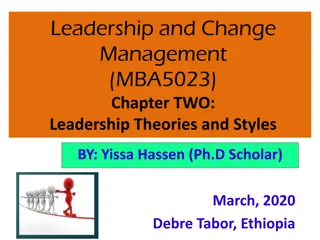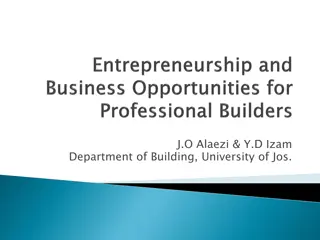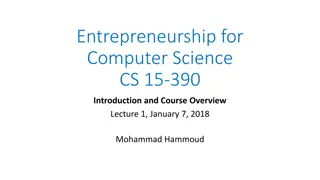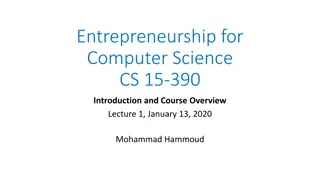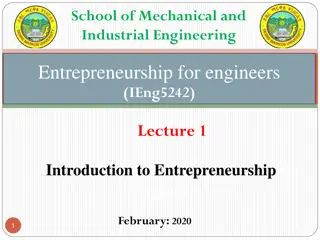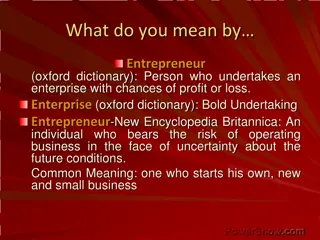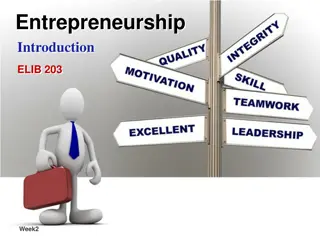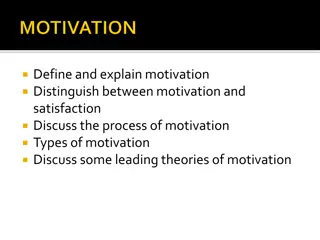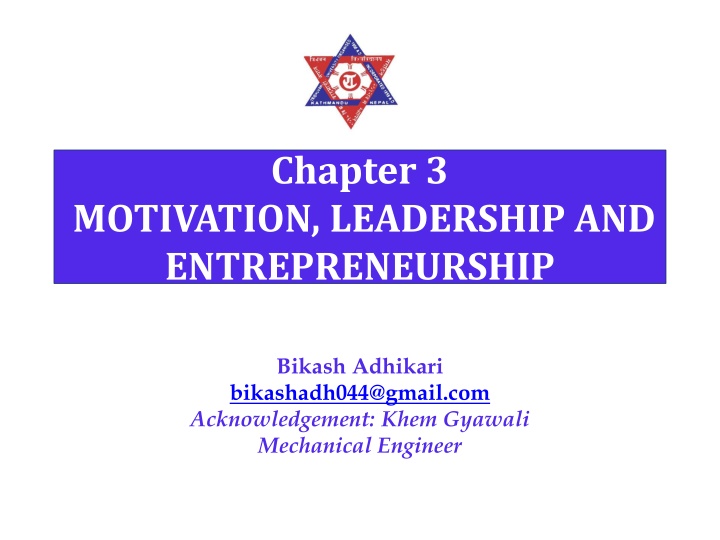
Motivation: Human Needs and Maslow's Hierarchy
Explore the intricacies of motivation in leadership and entrepreneurship, delving into human needs, Maslow's Hierarchy, and techniques to inspire individuals and groups towards achieving goals efficiently. Gain insights into primary and secondary needs and how to integrate them effectively in organizational settings.
Download Presentation

Please find below an Image/Link to download the presentation.
The content on the website is provided AS IS for your information and personal use only. It may not be sold, licensed, or shared on other websites without obtaining consent from the author. If you encounter any issues during the download, it is possible that the publisher has removed the file from their server.
You are allowed to download the files provided on this website for personal or commercial use, subject to the condition that they are used lawfully. All files are the property of their respective owners.
The content on the website is provided AS IS for your information and personal use only. It may not be sold, licensed, or shared on other websites without obtaining consent from the author.
E N D
Presentation Transcript
Chapter 3 MOTIVATION, LEADERSHIP AND ENTREPRENEURSHIP Bikash Adhikari bikashadh044@gmail.com Acknowledgement: Khem Gyawali Mechanical Engineer
Motivation -course outline Human needs Maslow s Hierarchy of needs Motivation Introduction Types of Motivation Attitude Motivation; Group Motivation; Executive Motivation Techniques of Motivation Motivation Theories 2
1. Motivation The term motivation is derived from the word motive which may be defined as needs, wants, drives or impulses within an individual. Motivation is a general term applying to the entire class of drives, desires, needs, wishes and similar forces that induce an individual or a group of people to work. From the definitions, it is clear that motivation has two aspects: 1. The knowledge of human needs. 2. To inspire the employees to their best towards the goals of the enterprise. The employers use the finding of the study of motivation in making their employees work more and better in the accomplishment of the organization s objectives through satisfaction of the employee needs. 3
I. Human Needs Expectation of the worker: 1. Certain goals to be fulfilled. 2. Right to choose a specific job. 3. Responsibility to fulfill his reasonable goals. Understanding human behavior: 1. Understand the behavior. 2. Integrate the interests and needs of the employers with the objectives of the organization. 3. Un co-operative, indifferent, unfriendly. 4. Have full knowledge of human behavior. 5. Know what satisfies the employee. 6. Co-operative working environment. 4
II. Maslows Hierarchy of Needs Maslow advanced three important propositions about human behavior. 1. Men are wanting being:Their needs are unlimited and continuous. As soon as one need is satisfied, another appears in its place. The process is unending. It continues from birth to death. It keeps man to work continuously. 2. Fresh needs can motivate persons to work: A satisfied need is not a motivator of behavior, only the needs which are not satisfied are capable of motivating individuals. 3. Man s needs have a hierarchy of importance:According to Maslow man s needs are arranged in a series of levels. He classified the needs into five ascending levels, in which each level must be satisfied before going on to the next. The lower level needs have priority over higher level needs. 5
II. Maslows Hierarchy of Needs Needs can be broadly classified into two categories as follows: 1. Primary needs: i. Physiological (basic): Satisfying basic needs for food, shelter, clothing, water, air, sleep, sex etc. ii. Safety: Safety from physical harm. Protection against deprivation, danger, threat etc. 2. Secondary needs: i. Social: Desire to be accepted, liked and loved. ii. Ego/esteem: Recognition and need for self-respect, status, independence etc. iii. Self-realization: Ability to realize one s capabilities and to work for one s interest advancement). (self-development, self- 7
III. Motivation- Introduction Motivation the forces within the individual that account for the level, direction, and persistence of effort expended at work. Extrinsic rewards valued outcomes given to someone by another person. Intrinsic rewards valued outcomes that occur naturally as a person works on a task. The following characteristics make the study of motivation very complicated: One type of need is different individuals produce different behaviors. Needs keep on changing absolutely and their intensity changes from time to time. People cannot express some of their needs in specific terms for social, cultural and other factors. In any situation more than one need may be operating. 1. 2. 3. 4. 8
III. Motivation- Introduction Outcomes & Inputs Regardless of the source of motivation, people seek outcomes. Outcome:anything a person gets from a job. Examples include pay, autonomy, accomplishment. Organizations hire workers to obtain inputs: Input: anything a person contributes to their job. Examples include skills, knowledge, work behavior. Managers thus use outcomes to motivate workers to provide inputs. 9
III. Motivation- Introduction Motivation Equation 10
IV. Types of Motivation There are many different forms of motivation. Each one influences behavior in its own unique way. No single type of motivation works for everyone. People s personalities vary and so accordingly does the type of motivation, that is most effective at inspiring their conduct. Incentive: A form of motivation that involves rewards, both monetary and nonmonetary is often called incentive motivation. Many people are driven by the knowledge that they will be rewarded in some manner for achieving a certain target or goal. Bonuses and promotions are good examples of the type of incentives that are used for motivation. Fear:Fear motivation involves consequences. This type of motivation is often one that is utilized when incentive motivation fails. In a business style of motivation often referred to as the, carrot and stick, incentive is the carrot and fear is the stick. 11
IV. Types of Motivation Achievement: Achievement motivation is also commonly referred to as the drive for competency. We are driven to achieve goals and tackle new challenges. We desire to improve skills and prove our competency both to others and to ourselves. Generally, this feeling of accomplishment and achievement is intrinsic in nature. Growth: The need for self-improvement is truly an internal motivation. A burning desire to increase our knowledge of ourselves and of the outside world can be a very strong form of motivation. We seek to learn and grow as individuals. Power: The motivation of power can either take the form of a desire for autonomy or other desire to control others around us. We want to have choices and control over our own lives. We strive for the ability to direct the manner in which we live now and the way our lives will unfold in the future. Social: Many people are motivated by social factors. This may be a desire to belong and to be accepted by a specific peer group or a desire to relate to the people in our sphere or in the larger world. We have an innate need to feel a connection with others. We also have the need for acceptance and affiliation. 12
V. Attitude Motivation, Group Motivation and Executive Motivation Attitude or self motivation: Being self-motivated means being ready for driven, focused discussion and behavior. It also means being sharp and smart enough not to be manipulated and to be open to positive learning. Being in this state of mind is the challenge! Causes of decrease in self-motivation. 1. Monotonous work. 2. Driven by boss. 3. Bad physical condition. 4. Does not get along with associates. 5. Financial problem. 13
V. Attitude Motivation, Group Motivation and Executive Motivation Effects of decrease in self-motivation. 1. Unwilling to work. 2. Creates sympathy. 3. Inferiority complex. Solutions to decrease in self-motivation. 1. Making the job more interesting. 2. Thinking constructively. 3. Making the best possible use of one s strong points and not dwelling on weakness. 4. Adopting oneself to the situation. 5. Acquiring the sensible and worthwhile principle of life. 14
V. Attitude Motivation, Group Motivation and Executive Motivation Necessities of Group Motivation Fairness Truthfulness Honesty Loyalty Stability Tolerance Ability to assume responsibility and co-operation Constructive criticism Compromise when necessary Orderliness in mind and action A sense of humor 15
V. Attitude Motivation, Group Motivation and Executive Motivation Executive Motivation Greater degree of the need for achievement. Concerned more about actualization, esteem and social needs. Techniques They are doing something that they call their own. They do tasks they have set for themselves. They can see what they have done. They feel that their job is important. They are secure. Challenge in work. Belief in the value of the work. 16
V. Attitude Motivation, Group Motivation and Executive Motivation Reasons for low executive motivation. Unsatisfactory bosses. Advancement is limited. Poor pay. Security threatened. 17
VI. Techniques of Motivation 1. Financial Motivators. a. Money 2. Non-financial motivators. a. Appraisal, praise or recognition. b. Status and pride. c. Competition. d. Delegation of authority. e. Participation. f. Job security. g. Job enlargement. h. Quality of work life. 18
VII. Motivation Theories McGregor s Theory X - Y Fear and Punishment Theory Alderfer s ERG Theory MacClelland s Theory of learned needs Herzberg s Hygiene Maintenance Theory Vroom s Expectancy/ Valency Theory 19
A. McGregors Theory X - Y The concept of Theory X and Theory Y managers was first developed by Douglas McGregor. He was able to show that Theory Y managers are better able to create employee engagement. Theory X workers: Don t like working Do as little as they can get away with Don t like things to change Need to be told what to do Cant be trusted to make a decision Are only interested in MONEY Must be closely watched Cant be trusted or relied upon 20
McGregors Theory X - Y Theory Y workers: Enjoy their work Will work hard to get rewards Want to see new things happening Will work independently Can be trusted to make decisions Are motivated by things other than money Can work unsupervised 21
B. Fear and Punishment Theory Deterrence is a theory from behavioral psychology about preventing or controlling actions or behavior through fear of punishment or retribution. This theory of criminology is shaping the criminal justice system of the United States and various other countries. Deterrence can be divided into two separate categories. General deterrence manifests itself in policy whereby examples are made of deviants. The individual actor is not the focus of the attempt at behavioral change, but rather receives punishment in public view in order to deter other individuals from deviance in the future. For example, in the Islamic Crime & Punishment system (Hoodoo), applied 1400 years ago, the punishment for crimes was performed in public, and was aimed at general social deterrence. Specific deterrence focuses on the individual deviant and attempts to correct his or her behavior. Punishment is meant to discourage the individual from recidivating. At the military level, the principle is expressed in deterrence theory. There is some debate over whether deterrence is achieved through the higher probability of arrest and conviction, and/or, severity of punishment, or denunciation, and whether it is aimed at others or the offender themselves or both. 22
C. Alderfer's ERG theory Clayton Alderfer's ERG (Existence, Relatedness, Growth) theory is built upon Maslow's hierarchy of needs theory. To begin his theory, Alderfer collapses Maslow's five levels of needs into three categories. Existence needs are desires for physiological and material well being. (In terms of Maslow's model, existence needs include physiological and safety needs) Relatedness needs relationships. (In terms of Maslow's model, relatedness correspondence to social needs) are desires for satisfying interpersonal Growth needs are desires for continued psychological growth and development. (In terms of Maslow's model, growth needs include esteem and self realization needs) 23
C. Alderfer's ERG theory After lower level needs satisfied, person seeks higher needs. When unable to satisfy higher needs, lower needs motivation is raised. 24
D. McClelland's Theory of learned needs David McClelland's acquired needs theory recognizes that everyone prioritizes needs differently. He also believes that individuals are not born with these needs, but that they are actually learned through life experiences. McClelland identifies three specific needs: Need for achievement is the drive to excel. Need for power is the desire to cause others to behave in a way that they would not have behaved otherwise. Need for affiliation is the desire for friendly, close interpersonal relationships and conflict avoidance. McClelland associates each need with a distinct set of work preferences, and managers can help tailor the environment to meet these needs. High achievers differentiate themselves from others by their desires to do things better. These individuals are strongly motivated by job situations with personal responsibility, feedback, and an intermediate degree of risk. In addition, high achievers often exhibit the following behaviors. 25
E. Herzbergs Hygiene Maintenance Theory Herzberg showed that satisfaction and dissatisfaction at work almost always arose from different factors According to Helzberg, Man has two sets of needs: As a human being to grow psychologically As an animal to avoid pain 26
E. Herzbergs Hygiene Maintenance Theory Focuses on outcomes that can lead to high motivation, job satisfaction, & those that can prevent dissatisfaction. Motivator needs: related to nature of the work and how challenging it is. Outcomes are autonomy, responsibility, interesting work. Hygiene needs: relate to the physical & psychological context of the work. Refers to a good work environment, pay, job security. When hygiene needs not met, workers are dissatisfied. Note: when met, they will NOT lead to higher motivation, just will prevent low motivation. 27
F. Vrooms Expectancy/ Valency Theory Developed by Victor Vroom and is a very popular theory of work motivation. Vroom suggests that motivation will be high when workers feel: High levels of effort lead to high performance. High performance will lead to the attainment of desire outcomes. Consists of three areas: Expectancy, Instrumentality, & Valence. Performance Outcomes Effort Expectancy: Person s perception that their effort will result in performance Instrumentality perception that performance results in outcomes Valence: How desired are the outcomes from a job 28
F. Vrooms Expectancy/ Valency Theory Expectancyis the perception that effort (input) will result in a level of performance. You will work hard if it leads to high performance. You would be less willing to work hard if you knew that the best you would get on a paper was a D regardless of how hard you tried. Instrumentality: Performance leads to outcomes. Workers are only motivated if they think performance leads to an outcome. Managers should link performance to outcomes. Valence: How desirable each outcome is to a person. Managers should determine the outcomes workers want most. 29
F. Vrooms Expectancy/ Valency Theory According to the Expectancy Theory, high motivation results from high levels of Expectancy, Instrumentality, & Valence. If just one value is low, motivation will be low. This means that even if desired outcomes are closely link to performance, the worker must feel the task is possible to achieve for high motivation to result. Managers need to consider this relationship to build a high performance firm. High Valence (Worker desires the outcomes resulting from high performance) High High Expectancy (Worker knows that if they try, they can perform) Instrumentality (Worker perceives that high performance leads to outcomes) High Motivation 30
THANK YOU!!! 31
2. Leadership course outline Qualities of a good Leader Leadership Style Blakes and Mouton s Managerial Grid Leadership Approach Leadership Theories 32
2. Leadership What is leadership? Leading people Influencing people Commanding people Guiding people 33
2. Leadership Types of Leaders Leader by the position achieved Leader by personality, charisma Leader by moral example Leader by power held Intellectual leader Leader because of ability to accomplish things 34
Managers vs. Leaders Managers Focus on things Do things right Plan Organize Direct Control Follows the rules Leaders Focus on people Do the right things Inspire Influence Motivate Build Shape entities 35
Managers vs. Leaders Common Activities Planning Organizing Directing Controlling 36
Managers vs. Leaders Planning Manager Planning Budgeting Sets targets Establishes detailed steps Allocates resources Leader Devises strategy Sets direction Creates vision 37
Managers vs. Leaders Organizing Manager Creates structure Job descriptions Staffing Hierarchy Delegates Training Leader Gets people on board for strategy Communication Networks 38
Managers vs. Leaders Directing Work Leader Empowers people Cheerleader Manager Solves problems Negotiates Brings to consensus 39
Managers vs. Leaders Controlling Manager Implements control systems Performance measures Identifies variances Fixes variances Leader Motivate Inspire Gives sense of accomplishment 40
I. Qualities of Good Leader Guiding vision: Effective leaders know what they want to do, and have the strength of character to pursue their objectives in the face of opposition and in spite of failures. The effective leader establishes achievable goals. Passion: Effective leaders believe passionately in their goals. They have a positive outlook on who they are, and they love what they do. Their passion for life is a guiding star for others to follow, because they radiate promise! Integrity: Because they know who they are, effective leaders are also aware of their weaknesses. They only make promises they can follow through on. 41
I. Qualities of Good Leader Honesty: Leaders convey an aura of honesty in both their professional and their personal lives. Trust: Effective leaders earn the trust of their followers and act on behalf of their followers. Curiosity: Leaders are learners. They wonder about every aspect of their charge. They find out what they need to know in order to pursue their goals. Risk: Effective leaders take calculated risks when necessary to achieve their objectives. If a mistake is made, the effective leader will learn from the mistake and use it as an opportunity to explore other avenues. 42
I. Qualities of Good Leader Dedication: The effective leader is dedicated to his or her charge, and will work assiduously on behalf of those following. The leader gives himself or herself entirely to the task when it is necessary. Charisma: This may be the one attribute that is the most difficult to cultivate. It conveys maturity, respect for your followers, compassion, a fine sense of humor, and a love of humanity. The result is that leaders have the capability to motivate people to excel. Listening: Leaders Listen! This is the most important attribute of all, listen to your followers. 43
II. Leadership Style A leadership style where the leader makes independently consulting with others. Thinks that he is only the competent and capable individual. When decision must be made & acted on quickly and without questions Advantages: good circumstances, such as urgent tasks or military actions Disadvantages: poor poor level of employee motivation all or decisions without Autocratic in certain decisions, 44
II. Leadership Style A leadership style where a leader encourages employee participation in decision-making Co-operation in attainment of goals. Delegate as much responsibility as their experience & knowledge will permit. Takes all the decisions and accepts full responsibility. persuasive or consultative Advantages: better employee motivation Disadvantages: delayed decision, long consultation Democratic decisions, 45
II. Leadership Style A leadership style where employees are encouraged to make their own decisions within limits. Expects his sub-ordinates to assume responsibility for their own motivation guidance and control. Discipline and control are not enforced. Managers give employees almost total authority in all matters. Advantages: more freedom for employees Disadvantages: few guidelines, little incentive, poor motivation, maybe a mess Laissez-faire 46
II. Leadership Style Factors affecting leadership styles The task The tradition of an organization The type of labor force The leader s personality The time Gender? 48
III. Blakes and Moutons Managerial Grid A popular framework for thinking about a leader s task versus person orientation was developed by Robert Blake and Jane Mouton in the early 1960s. Called the Managerial Grid, or Leadership Grid, it plots the degree of task-centeredness versus person-centeredness and identifies five combinations as distinct leadership styles. Understanding the Model The Managerial Grid is based on two behavioral dimensions: Concern for People This is the degree to which a leader considers the needs of team members, their interests, and areas of personal development when deciding how best to accomplish a task Concern for Production This is the degree to which a leader emphasizes concrete objectives, organizational efficiency and high productivity when deciding how best to accomplish a task. Using the axis to plot leadership concerns for production versus concerns for people , Blake and Mouton defined the following five leadership styles: 49



